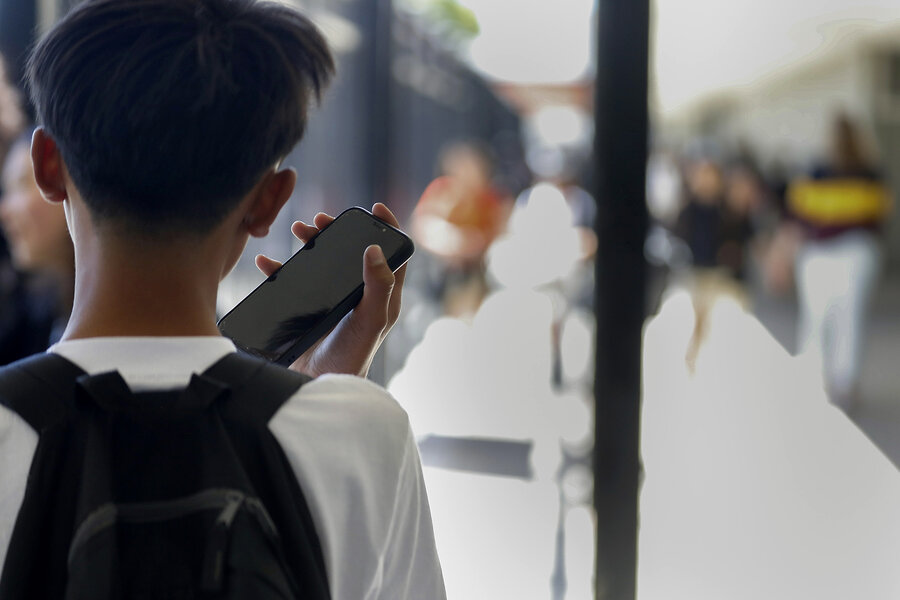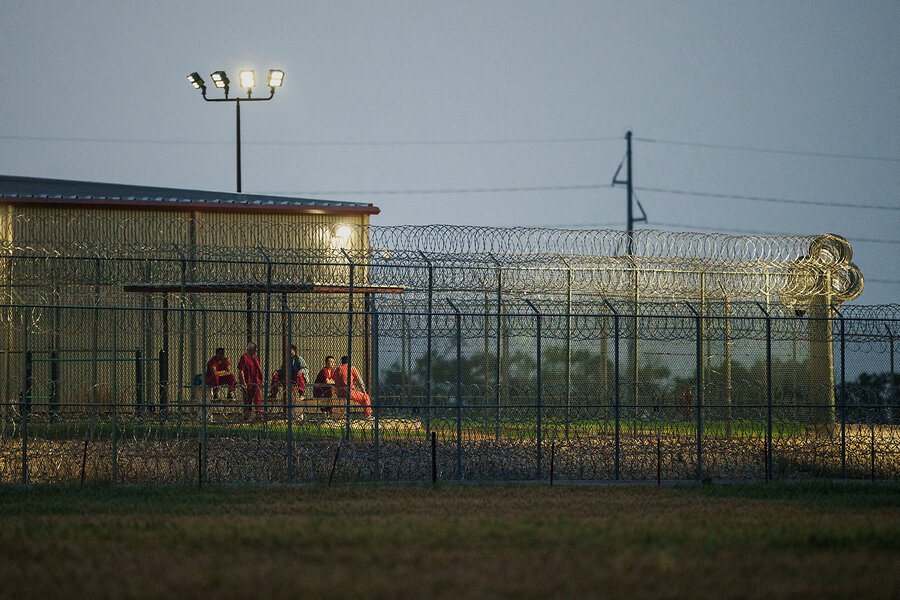Now Reading: Should cellphones be in class? More states are saying no.
-
01
Should cellphones be in class? More states are saying no.
Should cellphones be in class? More states are saying no.

As school winds down for children in the United States, one issue heating up is banning student cellphones.
In May, Georgia, Alabama, Nebraska, and Oklahoma finalized laws aimed at keeping personal tech out of the academic day. New York included a ban policy in its latest budget, signed by the governor May 9. At least two states, Texas and Rhode Island, have bills actively being considered in state legislatures. Five states, including Iowa and Utah, enacted new laws in April banning cellphone use.
The result is a groundswell across the country, with more than 20 states that have prohibited or limited the use of cellphones. Several others, including Connecticut, offer guidance encouraging districts to restrict access.
Why We Wrote This
The end of the academic year has brought a crescendo of laws in the U.S. aimed at restricting cellphone use in K-12 schools. The efforts reflect an increasing sense that student well-being and success depend on tech and social media guardrails.
The increase in bans is part of growing calls for a multipronged approach to helping young people balance tech and social media in their lives as they learn how to use it.
“We protected our kids before from cigarettes, alcohol, and drunk driving, and now, we’re protecting them from addictive technology designed to hijack their attention,” said New York Gov. Kathy Hochul, a Democrat, announcing that as of September, public schools would be smartphone-free from “bell-to-bell.”
The momentum coincides with survey results from April showing that almost 50% of teens think social media has a mostly negative effect on people their age. Educators have been among those who have asked politicians to consider bans.
About “90% of my day was taken up with drama regarding cellphones,” recalls Jen Butler of her time as a counselor at a private school in Philadelphia that serves students in sixth through 12th grade. “It was chaotic,” she says.
A bill to make social media platforms off-limits for children under age 18 is also in motion in Texas. It and at least nine other states already have laws on the books about social media access and minors. “There is no greater action we could take to protect our children than to eliminate this harmful product from their lives,” Republican state Rep. Jared Patterson, the Texas bill’s author, wrote on X.
More than two-thirds of U.S. adults, 68%, say they support cellphone bans in class for middle and high school students. Fewer of them, 36%, support all-day bans, according to Pew Research Center.
Florida led the way on cellphone bans in 2023, and some schools and districts have been experimenting with restrictions without state mandates. Oklahoma’s ban is in effect for the 2025-2026 school year, and is optional for districts after that.

USA Today Network/Reuters
Gov. Kim Reynolds signs a bill banning cellphones in schools at the Iowa State Capitol in Des Moines, April 30, 2025. Alabama, Georgia, and Oklahoma also enacted school cellphone laws in the spring of 2025.
One approach schools have taken is to use $25 magnetic pouches to secure phones during the day. That may be an option in New York state, where the government has set aside $13.5 million to help with storage.
Last August, the Connecticut State Board of Education approved voluntary guidelines for districts to create their own cellphone policies and recommended restrictions removing cellphones from all elementary and middle school classrooms. A Connecticut public high school using pouches this year reports higher grades and better student behavior during the day.
When Ms. Butler, the counselor, transitioned in 2023 to a job at The Country School in Madison, Connecticut, which had implemented cellphone restrictions in 2018, her experience changed. Students played at recess instead of bending over screens in their palms, she says. They knew how to talk to their friends face-to-face instead of texting from a few feet away.
Teachers at the private school, which now has years of experience with an all-day ban, say that their students seem more social, more engaged in class, and more prepared for navigating technology.
Bill Leidt, the director of technology when the policy was first implemented, says the school took action when cellphones became “an enormous distraction,” on top of a handful of inciting incidents involving phones and social media. At the time, he faced pushback from parents and students. He “wasn’t on anybody’s Christmas card list,” he says.
Cellphone policies should be tailored to each school and be built by the community, says Renee Hobbs, professor of communication studies at the University of Rhode Island’s Harrington School of Communication and Media.
When these decisions are made “with community input, through a community-based process … that’s local education at its very finest,” Dr. Hobbs says.
In some cases, efforts to ban cellphones also include tech education components. Alabama’s law, called the Freeing Our Classrooms of Unnecessary Screens for Safety (FOCUS) Act, requires the state’s department of education to offer social media training for students prior to eighth grade. Joe LaMacchia, the current director of technology at The Country School in Connecticut, says he also walks classes through topics like digital footprint safety.
Students at that school have adapted to the phone-free environment – though some still sneak devices into bathrooms trying to get screen time, teachers say. Upper elementary students have mixed feelings about cellphones in general. One girl worries her friends “would be texting me late at night, and that would get overwhelming,” she says. Another has concerns about becoming like her older sibling and his friends, “glued to their phones, even on the chair lift.”
For Ms. Butler, what stands out is that human interaction has become more present when cellphones are largely absent.
“The kids are really engaging, and it’s so healthy to see,” she says. “They’re much more open to a mediation or … to [talking things] out with a friend or an adult.”

























